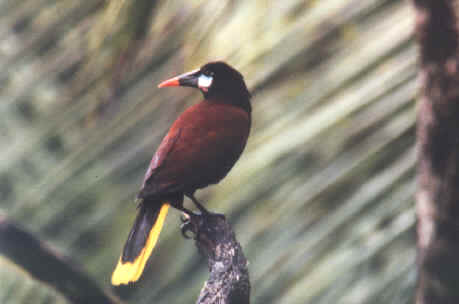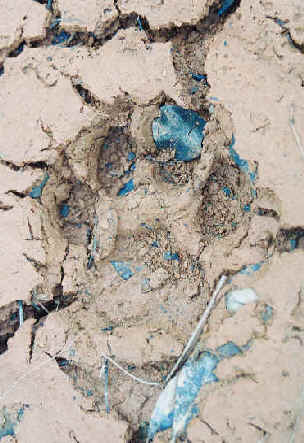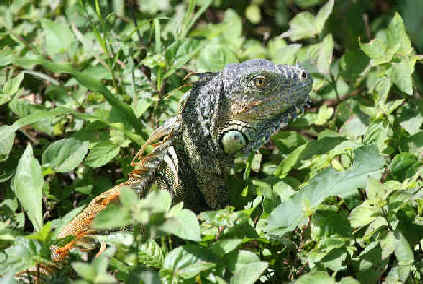 Belize
Birds
Belize
Birdsduring the FONT Birding
& Nature Tour
 Belize
Birds
Belize
Birds
during the FONT Birding
& Nature Tour
in March 2007
List compiled by Armas Hill
c
b: Cockscomb Basin Wildlife Sanctuary & Maya CentreLinks:
& Other Wildlife in Central AmericaButterflies in Central America
Belize Tour HighlightsUpcoming
Central America Tour Itineraries
![]()
Bird-List:
Mammals & Other Nature
during our March 2007 tour
in Belize
Mammals:

Other Nature:

![]()
Birds at Various Places during our Belize Tour
March 20-30, 2007
The area of CROOKED TREE:
1 - Pied-billed Grebe
2 - Neotropic Cormorant
3 - Great Blue Heron
4 - Great Egret
5 - Snowy Egret
6 - Little Blue Heron
7 - Tricolored Heron
8 - Cattle Egret
9 - Black-crowned Night Heron
10 - Glossy Ibis
11 - Wood Stork
12 - Blue-winged Teal
13 - Black Vulture
14 - Turkey Vulture
15 - Lesser Yellow-headed Vulture
16 - Osprey
17 - White-tailed Kite
18 - Snail Kite
19 - Black-collared Hawk
20 - Great Black Hawk
21 - Roadside Hawk
22 - Northern Crested Caracara (rare in Belize)
23 - Gray-necked Wood Rail
24 - Purple Gallinule
25 - Limpkin
26 - Northern Jacana
27 - SOUTHERN LAPWING (rare in Belize)
28 - Spotted Sandpiper
29 - Laughing Gull
30 - Gull-billed Tern
31 - Forster's Tern
32 - Mourning Dove
33 - Ruddy Ground Dove
34 - White-fronted Amazon
35 - Red-lored Amazon
36 - Ringed Kingfisher
37 - Collared Aracari
38 - Acorn Woodpecker
39 - Golden-fronted Woodpecker
40 - Lineated Woodpecker
41 - Fork-tailed Flycatcher
42 - Tropical Kingbird
43 - Couch's Kingbird
44 - Social Flycatcher
45 - Great Kiskadee
46 - Vermilion Flycatcher
47 - Clay-colored Thrush
48 - Tropical Mockingbird
49 - Gray-breasted Martin
50 - Mangrove Swallow
51 - "Southern" House Wren
52 - Yellow Warbler
53 - "Myrtle" Yellow-rumped
Warbler
54 - Yellow-throated Warbler (with us on the porch at breakfast)
55 - American Redstart
56 - Blue-gray Tanager
57 - White-collared Seedeater
58 - Great-tailed Grackle
59 - Melodious Blackbird
60 - Red-winged Blackbird
61 - Baltimore Oriole
62 - Hooded Oriole
The vicinity of ALTUN HA
(Mayan ruins north of Belize City)
1 - Anhinga
2 - Great Egret
3 - Snowy Egret
4 - Little Blue Heron
5 - Cattle Egret
6 - American White Ibis
7 - Wood Stork
8 - Black-bellied Whistling Duck
9 - Black Vulture
10 - Turkey Vulture
11 - Roadside Hawk
12 - Bat Falcon
13 - Lesser Yellowlegs
14 - Solitary Sandpiper
15 - White-tipped Dove
16 - Gray-fronted Dove
17 - Aztec Parakeet
18 - Black-headed Trogon
19 - Violaceous Trogon
20 - Keel-billed Toucan
21 - Acorn Woodpecker
22 - Lineated Woodpecker
23 - Tropical Kingbird
24 - Boat-billed Flycatcher
25 - Social Flycatcher
26 - Great Kiskadee
27 - Vermilion Flycatcher
28 - Tropical Pewee
29 - Brown Jay
30 - Tropical Mockingbird
31 - "Southern" House Wren
32 - White-breasted Wood Wren
33 - Yellow Warbler
34 - Magnolia Warbler
35 - "Myrtle" Yellow-rumped
Warbler
36 - Northern Waterthrush
37 - Blue-gray Tanager
38 - Yellow-winged Tanager
39 - Black-headed Saltator
40 - Northern Cardinal
41 - White-collared Seedeater
42 - Great-tailed Grackle
43 - Melodious Blackbird
44 - Black-cowled Oriole
45 - Montezuma Oropendola
The CAYO DISTRICT of western Belize
1 - Great Tinamou
2 - Little Tinamou
3 - Thicket Tinamou
4 - Slaty-breasted Tinamou
(all 4 tinamous were heard)
5 - Neotropic Cormorant
6 - Anhinga
7 - Great Blue Heron
8 - Great Egret
9 - Snowy Egret
10 - Little Blue Heron
11 - Cattle Egret
12 - Green Heron
13 - Bare-throated Tiger Heron
14 - JABIRU (at nest)
15 - Wood Stork
16 - Blue-winged Teal
17 - Black Vulture
18 - Turkey Vulture
19 - White-tailed Kite
20 - Snail Kite
21 - Black-collared Hawk
22 - Cooper's Hawk
23 - Gray Hawk
24 - Roadside Hawk
25 - White-tailed Hawk
26 - Laughing Falcon
27 - American Kestrel
28 - Bat Falcon
29 - Plain Chachalaca
30 - Ruddy Crake
31 - Gray-necked Wood Rail
32 - Purple Gallinule
33 - Common Moorhen
34 - Limpkin
35 - Northern Jacana
36 - Killdeer
37 - Solitary Sandpiper
38 - Spotted Sandpiper
39 - Semipalmated Sandpiper
40 - Common (or Feral) Pigeon
41 - Pale-vented Pigeon
42 - Short-billed Pigeon
43 - Plain-breasted Ground Dove
44 - Ruddy Ground Dove
45 - BLUE GROUND DOVE (about 3 dozen together)
46 - White-tipped Dove
47 - Aztec Parakeet
48 - White-fronted Amazon
49 - Squirrel Cuckoo
50 - Groove-billed Ani
51 - Barn Owl (6 on fenceposts, in less than a mile)
52 - Pauraque
53 - Yucatan Poorwill
54 - NORTHERN POTOO
55 - Vaux's Swift
56 - White-necked Jacobin
57 - Rufous-tailed Hummingbird
58 - Black-headed Trogon
59 - Violaceous Trogon
60 - Blue-crowned Motmot
61 - Ringed Kingfisher
62 - Green Kingfisher
63 - Keel-billed Toucan
64 - Golden-fronted Woodpecker
65 - Golden-olive Woodpecker
66 - Lineated Woodpecker
67 - Ivory-billed Woodcreeper
68 - Barred Antshrike
69 - Fork-tailed Flycatcher
70 - Tropical Kingbird
71 - Piratic Flycatcher
72 - Social Flycatcher
73 - Great Kiskadee
74 - Brown-crested Flycatcher
75 - Vermilion Flycatcher
76 - Least Flycatcher
77 - Yellow-bellied Flycatcher
78 - Tropical Pewee
79 - Yellow-bellied Elaenia
80 - Rose-throated Becard
81 - Masked Tityra
82 - Yellow-green Vireo
83 - Green Jay
84 - Brown Jay
85 - Wood Thrush
86 - Clay-colored Thrush
87 - Gray Catbird
88 - Mangrove Swallow
89 - Ridgways' Rough-winged Swallow
90 - Barn Swallow
91 - Band-backed Wren
92 - Black-and-white Warbler
93 - Prothonotary Warbler
94 - Blue-winged Warbler
95 - Yellow Warbler
96 - Magnolia Warbler
97 - Northern Waterthrush
98 - American Redstart
99 - Yellow-breasted Chat
100 - Red-legged Honeycreeper
101 - Yellow-throated Euphonia
102 - Golden-hooded Tanager
103 - Blue-gray Tanager
104 - Yellow-winged Tanager
105 - Red-throated Ant Tanager
106 - Black-headed Saltator
107 - "Northern" Grayish
Saltator
108 - Blue Grosbeak
109 - Indigo Bunting
110 - "Black" Variable Seedeater
111 - White-collared Seedeater
112 - Blue-black Grassquit
113 - Yellow-faced Grassquit
114 - Eastern Meadowlark
115 - Great-tailed Grackle
116 - Melodious Blackbird
117 - Orchard Oriole
The area of MOUNTAIN PINE RIDGE
1 - Black Vulture
2 - Turkey Vulture
3 - Swallow-tailed Kite
4 - Plumbeous Kite
5 - White-collared Swift
6 - Acorn Woodpecker
7 - Social Flycatcher
8 - Northern Rough-winged Swallow
9 - Grace's Warbler
10 - Hepatic Tanager
11 - Indigo Bunting
12 - Yellow-faced Grassquit
13 - Rusty Sparrow
14 - Yellow-tailed Oriole
15 - Black-headed Siskin
The area of BANANA BANK
1 - Green Heron
2 - KING VULTURE (a black juvenile)
3 - Black Vulture
4 - Turkey Vulture
5 - Roadside Hawk
6 - Laughing Falcon
7 - American Kestrel
8 - Merlin
9 - Ruddy Ground Dove
10 - Aztec Parakeet
11 - Vaux's Swift
12 - Collared Aracari
13 - Golden-fronted Woodpecker
14 - Lineated Woodpecker
15 - Tropical Kingbird
16 - Piratic Flycatcher
17 - Great Kiskadee
18 - Great Crested Flycatcher
19 - Dusky-capped Flycatcher
20 - Cinnamon Becard
21 - Gray-collared Becard
22 - Brown Jay
23 - Tropical Mockingbird
24 - "Southern" House Wren
25 - Yellow Warbler
26 - Hooded Warbler
27 - Yellow-throated Euphonia
28 - Blue-gray Tanager
29 - Indigo Bunting
30 - White-collared Seedeater
31 - Blue-black Grassquit
32 - Great-tailed Grackle
33 - Melodious Blackbird
34 - Bronzed Cowbird
35 - Baltimore Oriole
36 - Hooded Oriole
Along the HUMMINGBIRD HIGHWAY
1 - Cattle Egret
2 - Baltimore Oriole
3 - Yellow-tailed Oriole
4 - Hooded Oriole
(yes, there were others, but not that many as it rained, and it was a quick pm drive)
Along the coast in & near PLACENICA
1 - Brown Pelican
2 - Anhinga
3 - Magnificent Frigatebird
4 - Cattle Egret
5 - Green Heron
6 - White-tailed Kite
7 - Common Black Hawk
8 - Roadside Hawk
9 - American Kestrel
10 - Spotted Sandpiper
11 - Sandwich Tern
12 - Royal Tern
13 - White-winged Dove
14 - Mourning Dove
15 - Ruddy Ground Dove
16 - Aztec Parakeet
17 - Fork-tailed Flycatcher
18 - Tropical Mockingbird
19 - Mangrove Swallow
20 - Yellow Warbler
21 - Blue-gray Tanager
22 - Blue-black Grassquit
23 - Great-tailed Grackle
24 - SHINY COWBIRD
The area of COCKSCOMB BASIN WILDLIFE
SANCTUARY
1 - Great Tinamou
2 - Little Tinamou
3 - Black Vulture
4 - Turkey Vulture
5 - Plumbeous Kite
6 - WHITE HAWK
7 - Laughing Falcon
8 - Bat Falcon
9 - Plain Chachalaca
10 - Ruddy Ground Dove
11 - Blue Ground Dove
12 - Gray-chested Dove
13 - Ruddy Quail-Dove
14 - Red-lored Amazon
15 - Pauraque
16 - White-bellied Emerald
17 - Rufous-tailed Hummingbird
18 - Slaty-tailed Trogon
19 - Blue-crowned Motmot
20 - Keel-billed Toucan
21 - Golden-fronted Woodpecker
22 - Smoky-brown Woodpecker
23 - Pale-billed Woodpecker
24 - Ivory-billed Woodcreeper
25 - Streak-headed Woodcreeper
26 - Barred Antshrike
27 - Dusky Antbird
28 - Tropical Kingbird
29 - Piratic Flycatcher
30 - Streaked Flycatcher
31 - Social Flycatcher
32 - Great Kiskadee
33 - Dusky-capped Flycatcher
34 - Tropical Pewee
35 - Common Tody-Flycatcher
36 - Yellow-bellied Elaenia
37 - Thrushlike Schiffornis
38 - Rose-throated Becard
39 - White-collared Manakin
40 - Yellow-green Vireo
41 - Brown Jay
42 - Clay-colored Thrush
43 - Northern Rough-winged Swallow
44 - Spot-breasted Wren
45 - "Southern" House Wren
46 - White-breasted Wood Wren
47 - Yellow Warbler
48 - Magnolia Warbler
49 - Red-legged Honeycreeper
50 - Olive-backed Euphonia
51 - Golden-hooded Tanager
52 - Blue-gray Tanager
53 - Yellow-winged Tanager
54 - Passerini's Tanager
55 - Crimson-collared Tanager
56 - Summer Tanager
57 - Blue Grosbeak
58 - "Black" Variable Seedeater
59 - White-collared Seedeater
60 - Blue-black Grassquit
61 - Yellow-faced Grassquit
62 - Great-tailed Grackle
63 - Melodious Blackbird
64 - Bronzed Cowbird
65 - Black-cowled Oriole
66 - Baltimore Oriole
67 - Orchard Oriole
68 - Montezuma Oropendola
The vicinity of GALE'S POINT (Manatee
Lodge)
1 - KING VULTURE (a black juvenile)
2 - Plain Chachalaca
3 - Spotted Sandpiper
4 - Laughing Gull
5 - Gull-billed Tern
6 - Sandwich Tern
7 - Royal Tern
8 - Common Tern
9 - Pale-vented Pigeon
10 - Ruddy Ground Dove
11 - Squirrel Cuckoo
12 - Ringed Kingfisher
13 - Belted Kingfisher
14 - Green Kingfisher
15 - Golden-fronted Woodpecker
16 - Tropical Kingbird
17 - Boat-billed Flycatcher
18 - Social Flycatcher
19 - Great Kiskadee
20 - Black Phoebe
21 - Brown Jay
22 - Tropical Mockingbird
23 - Mangrove Swallow
24 - Northern Rough-winged Swallow
25 - Barn Swallow
26 - Yellow Warbler
27 - White-collared Seedeater
28 - Great-tailed Grackle
29 - Black-cowled Oriole
30 - Montezuma Oropendola
West Indian Manatee
track of the Jaguar
At & near BIRD ISLAND
1 - Brown Pelican
2 - Magnificent Frigtebird
3 - Great Blue Heron
4 - Great Egret
5 - Snowy Egret
6 - Little Blue Heron
7 - Tricolored Heron
8 - Black-crowned Night Heron
9 - BOAT-BILLED HERON
10 - White Ibis
11 - Muscovy Duck
12 - Black Vulture
13 - Turkey Vulture
14 - Osprey
15 - Peregrine Falcon
16 - Barn Swallow
The offshore island of CAYE CAULKER
1 - Brown Pelican
2 - Double-crested Cormorant
3 - Magnificent Frigatebird
4 - Great Egret
5 - Snowy Egret
6 - Little Blue Heron
7 - Tricolored Heron
8 - Cattle Egret
9 - Green Heron
10 - Yellow-crowned Night Heron
11 - Muscovy Duck
12 - Osprey
13 - Black-bellied Plover
14 - Semipalmated Plover
15 - Greater Yellowlegs
16 - Spotted Sandpiper
17 - Whimbrel
18 - Ruddy Turnstone
19 - Sanderling
20 - Short-billed Dowitcher
21 - Laughing Gull
22 - Gull-billed Tern
23 - Sandwich Tern
24 - Royal Tern
25 - Common Tern
26 - Common (or Feral) Pigeon
27 - WHITE-CROWNED PIGEON
28 - White-winged Dove
29 - Green-breasted Mango
30 - Cinnamon Hummingbird
31 - Golden-fronted Woodpecker
32 - Tropical Kingbird
33 - YUCATAN VIREO
34 - Tropical Mockingbird
35 - Gray Catbird
36 - BLACK CATBIRD
37 - Barn Swallow
38 - Yellow Warbler
39 - MANGROVE WARBLER
40 - Yellow-throated Warbler
41 - American Redstart
42 - Bananaquit (the Yucatan race)
43 - SCRUB EUPHONIA (rare on offshore islands)
44 - Rose-breasted Grosbeak
45 - Great-tailed Grackle
To Top of Page